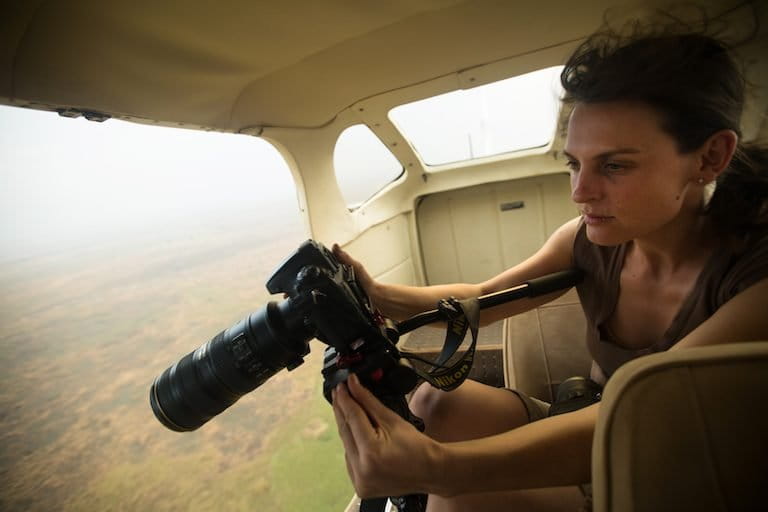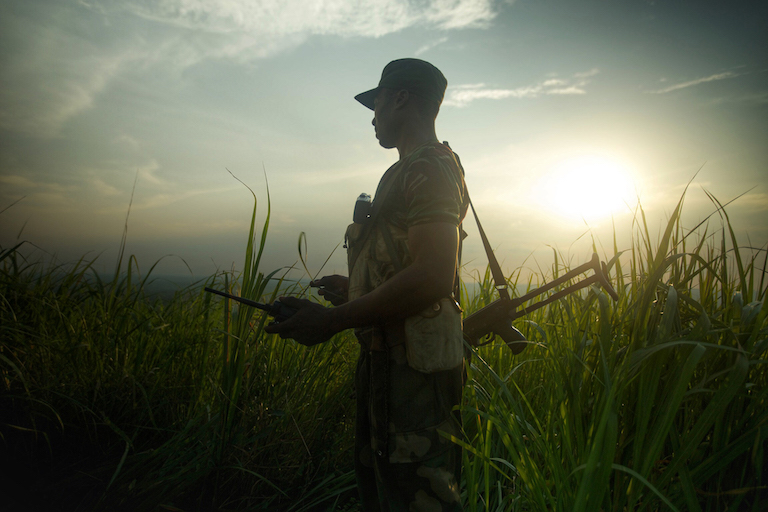- A deadly combination of consumer demand, transnational criminal syndicates and local poverty and conflict drives the illicit trade in ivory and rhino horn.
- War photographer turned filmmaker Kate Brooks traveled through four continents to document the wildlife trade for her film “The Last Animals.”
- The film is a finalist for the Special Jury award at the 2017 Jackson Hole Wildlife Film Festival in Jackson, Wyoming.
After years of documenting some of the world’s bloodiest conflicts, a vacation in Kenya inspired photojournalist Kate Brooks to turn her lens to a different kind of violence: the slaughter of elephants and rhinos to feed black-market demand for ivory and rhino horn.
Poaching is having a devastating impact on Africa’s wildlife.
From 2006 to 2015, the population of African elephants is estimated to have declined by around 110,000, leaving just 415,000 still alive in the wild. The situation is no better for the continent’s rhinos: demand for their horns as decorative items and in traditional medicine has caused more than 7,100 to have been poached in the last decade, leaving a population of just 25,000.
In her film “The Last Animals,” war-photographer turned filmmaker Kate Brooks traces this deadly trade across four continents — traveling from protected areas in Africa to wildlife markets in Asia and North America in order to illustrate the complex web of global consumer demand, transnational criminal syndicates and local conflicts and political problems that contribute to the current poaching epidemic. Along the way, Brooks also meets with investigators, scientists, zookeepers and rangers engaged in an all-too-often life threatening struggle to preserve the last remaining elephants and rhinos.
The Last Animals is a finalist for the Special Jury award in the 2017 Jackson Hole Wildlife Film Festival taking place September 24-29 in Jackson, Wyoming. Winners in 25 awards categories will be announced September 28.
In an email interview, Kate Brooks shared her experience documenting the plight of Africa’s elephants and rhinos, as well as her thoughts on what can be done to help these animals.

Mongabay: What inspired you to make a film about poaching and the wildlife trade?
Brooks: In 2010 after embedding with a medevac unit at Kandahar Airfield in Afghanistan as a photojournalist, I went to Kenya on a long-planned vacation. It was in the Maasai Mara that I was able to heal from some of the inhumanity I had witnessed: countless troops and Afghan civilians having their limbs blown off by IEDs and Afghan children being erroneously bombed by coalition forces.
Seeing a herd of elephants cross my eye line for the first time reminded me that in spite of all the human destruction on the planet, there is still some natural order which ultimately lead me to want to protect it.
A couple of years later I applied to the Knight Wallace Fellowship and was accepted as the Ford Environment, Transportation and Technology Fellow.
I saw stories trickling in about the poaching crisis, but the issue was largely underreported then. When I learned of an elephant massacre on the border of Chad in which over 80 elephants were gunned down, I felt I had no choice but to pick up my cameras to help bring attention to the crisis.
Mongabay: How did your background as a war photographer inform this project? And what parallels and connections do you see between the conflict zones you’ve worked in and the front lines of the trade in ivory and rhino horn?
Over the course of three years, I discovered a web of international criminal activity and a network of the most devoted people I have ever met – scientists, activist and conservationists working around the clock to protect the planet’s animals. The rangers who risk their lives every day to preserve the beauty and life that remain are the unsung heroes. I think what sets The Last Animals apart from many wildlife documentaries is that the film is more focused on the human beings than the animals themselves. Being on patrol with rangers in Garamba can be just as dangerous as being on a patrol with a military unit in Afghanistan and that is one of the reasons I went there – I wanted to document the front lines of this ivory war and put the human sacrifice into focus.

Mongabay: The film introduces the idea that warning signs about the northern white rhino — which is now going extinct before our eyes — could be seen decades ago, and that now the same kinds of signs are being seen with elephants. What are some of those signs, and what lessons should we learn from the fate of the northern white rhino?
Brooks: Wildlife is disappearing at such an alarming rate that it’s nearly impossible for the human mind to comprehend. In Chad I spent a few weeks with a group of conservationists searching by air and land for the country’s last elephants. Outside of Zakouma National Park, there are less than 300 left — desperate little groups, fighting for survival, shot up and becoming genetically isolated. In Garamba National Park, there are more militia in the park than giraffe, and the rangers who are fighting to protect the relatively few animals that remain are being killed in the process. There is a great deal of talk that elephants and rhinos could be extinct in the next 10-20 years, but the reality is that localized extinction is happening now.
The story of the Northern Whites is foreboding — what happens when too little is done too late, in spite of all the will and commitment in the world. We are at a critical moment in history and time is running out. The illegal wildlife trade is a global problem that requires global and local action from consumer responsibility to government action.
Mongabay: Ultimately, the film paints a pretty grim picture of the situation for elephants and rhinos. Were there things you encountered during filming that give you some hope?
Brooks: In spite of how grim the big picture is, there is also a lot that gives me hope. The US implemented a near total ban on the ivory trade last year and seven states have further banned intrastate trade with many other states trying to follow suit. China committed to banning the ivory trade by the end of 2017 and is following through on that commitment. Hong Kong is currently debating a ban as well. Wildlife trafficking penalties in Kenya have been stiffened to be a true deterrent rather than a slap on the wrist. There is also the Elephant Protection Initiative, which is an African sovereign-led initiative — the only one of its kind anywhere in the world — committed to the protection of a common natural resource: the African elephant. To date, there are more than a dozen African country signatories to the platform, which is recognized by the United Nations, various multi-laterals, and leading NGOs.

Mongabay: What messages do you hope people who view The Last Animals come away with?
Brooks: The film not only endeavors to expose the horrors of this crisis, and that extinction is real, but also how the trade is linked to the darkest sides of global criminal activity. My greatest hope is that The Last Animals will help close the world’s remaining ivory markets and raise awareness about how many species are threatened with extinction. The illegal wildlife trade is a global problem that requires global and local action. It’s imperative that countries and states shut down their domestic ivory markets and that illegal wildlife trafficking laws and penalties be stiffened.
Mongabay: What are some things people can do if they want to help elephants and rhinos survive?
People who want to get involved in the US should put pressure on their state to ban intrastate trade of ivory and ensure that wildlife trafficking laws and penalties are strict in their state. Wyoming for example has yet to implement a state ivory ban. We have a map on our website that shows which states have passed laws and which haven’t. If legislation is pending or has yet to be introduced, concerned citizens should send a letter to their State Senators and Assembly Members in support of ending the intrastate trade. If a bill has already passed both houses, but has not yet been signed, send a letter to the Governor. Having a robust legal frame work in place to protect vulnerable, threatened and endangered species is critical to combating environmental crime.

Mongabay: What’s next for you?
I’m in discussions about directing four different film projects next year – three are documentaries and one is a narrative. I would be thrilled to work on any of them. That said, The Last Animals festival run and impact campaign are going to be consuming a lot of my time for some time to come. We have dozens of screenings coming up around the world over the next couple of months and many booked into next year.
FEEDBACK: Use this form to send a message to the author of this post. If you want to post a public comment, you can do that at the bottom of the page.
Note: This article has been modified to correct the name of the Elephant Protection Initiative.
